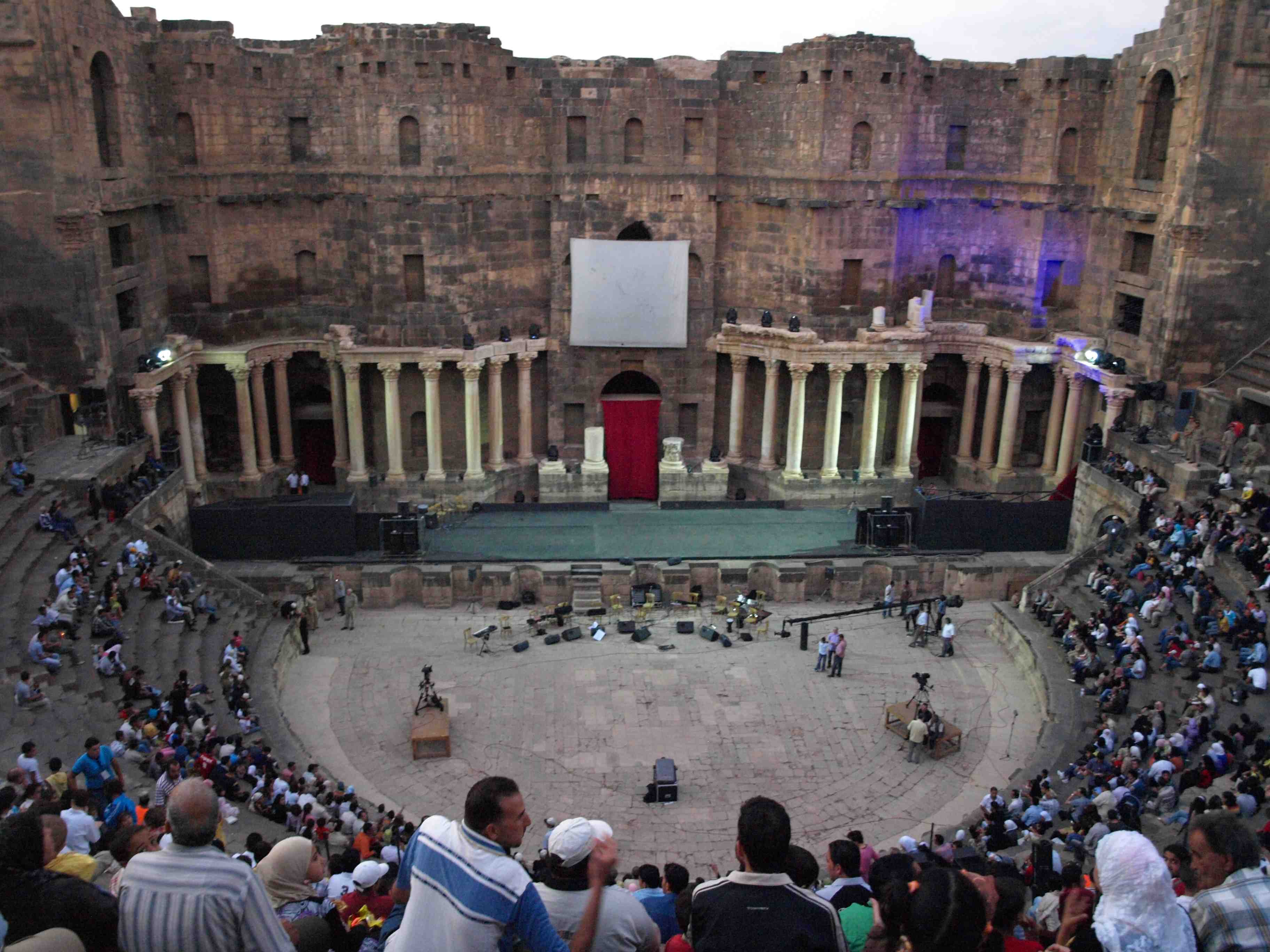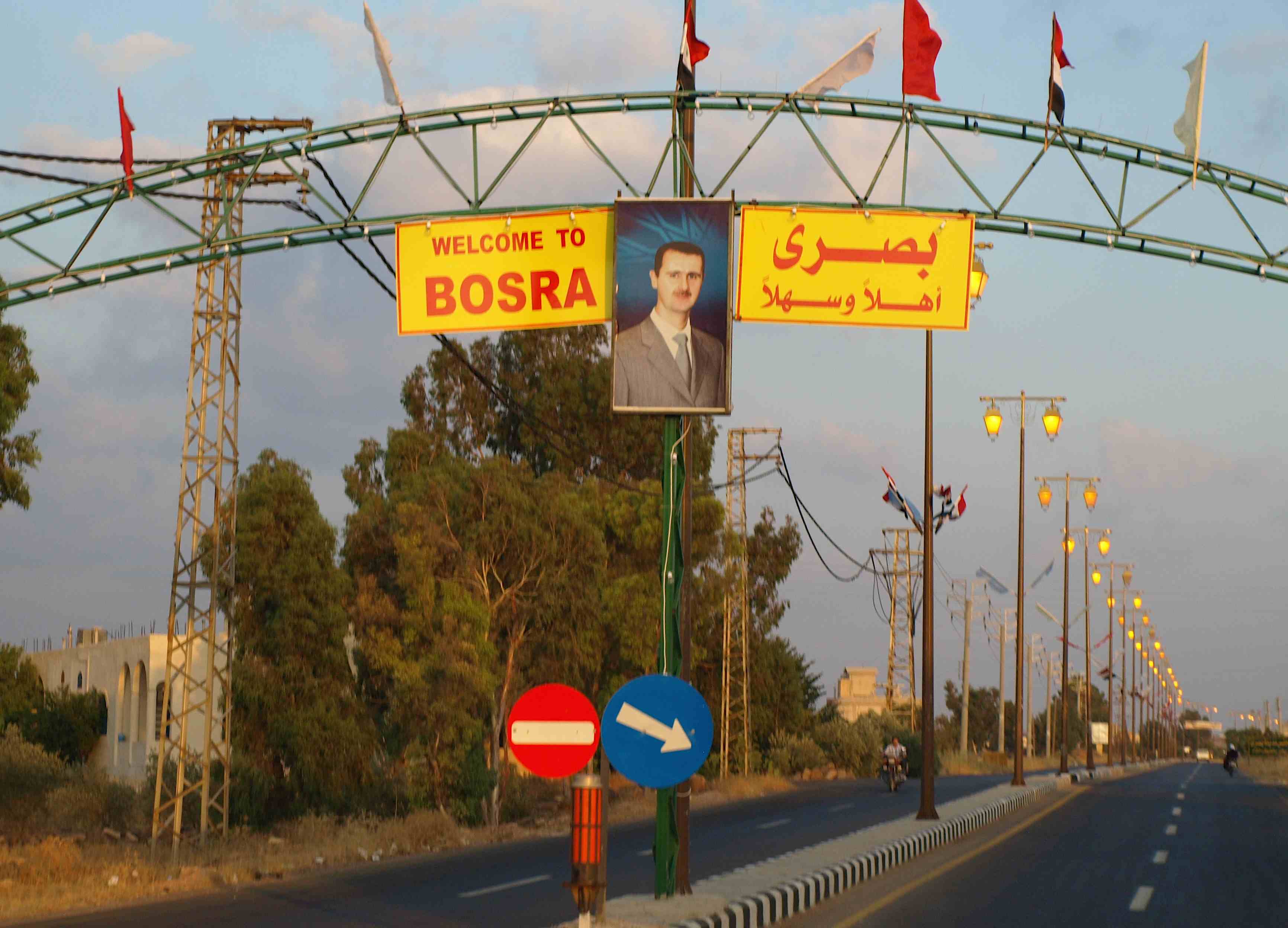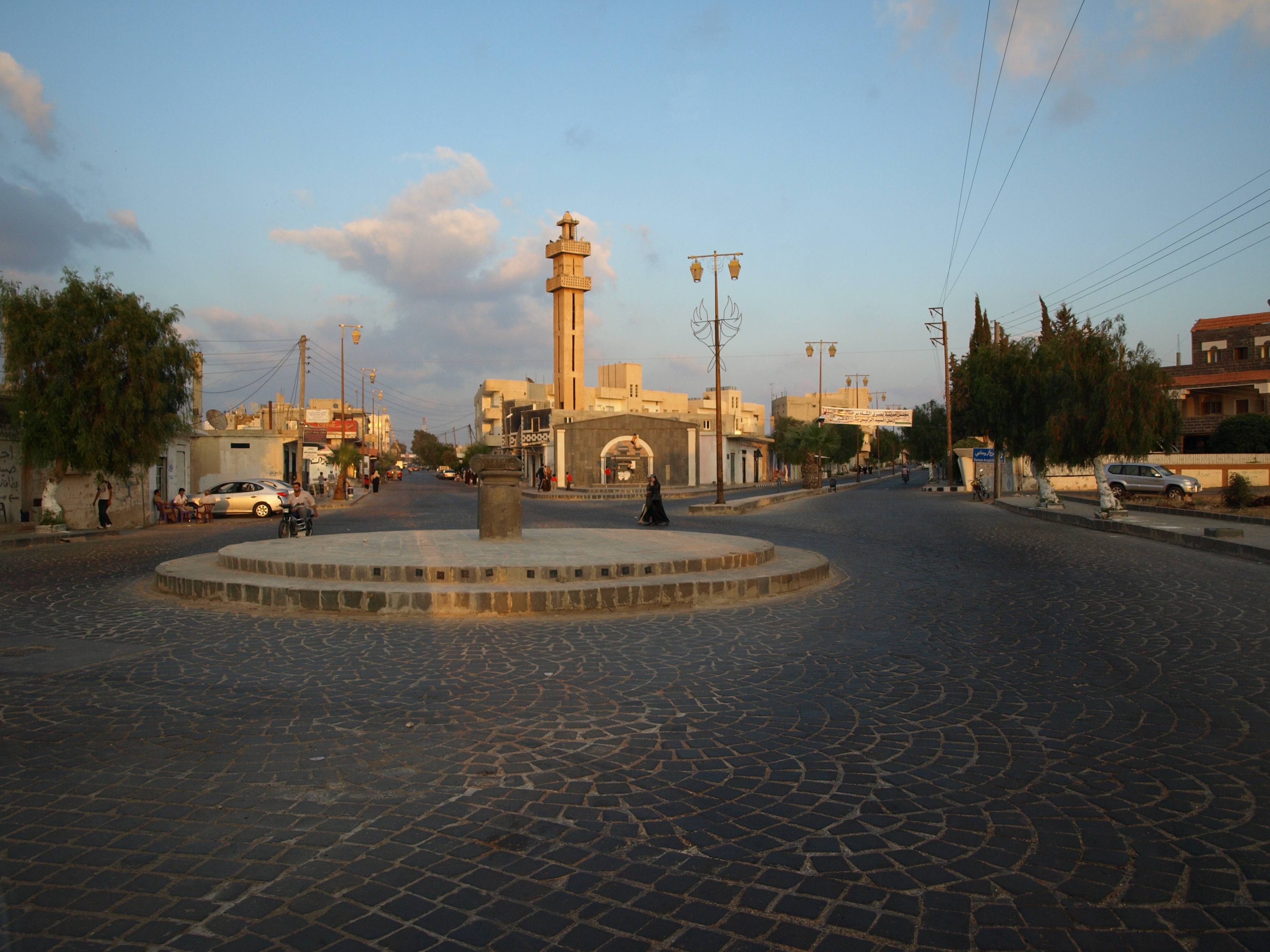Some Fires Burn More than Others
[August 10th, 2009] Bosra is on fire. Red lights shine through the night in the ancient Roman amphitheatre. The smoke pours onto the stage, where the famous pop singer, Ali al-Deek, and his orchestra have set the audience and the stage on metaphorical fire. Everyone is dancing: old men in traditional attire, women with children in their hands, with or without hijab on their hair, young men and women in groups, people in the front rows, at the back, on the stairs, officials, guests and dignitaries along with ordinary, village people. The impressive Roman theatre of Bosra, one of the world’s best preserved, located in the municipality of Dar’a, is filled beyond its fifteen hundred capacity. On the fourth day of the 21st International Bosra Festival (mahrajan Bosra al-dawly), the excitement is hard to contain, it spills and collects in the empty space between the stage and the rows where the audience sits - groups of people ride on the tide of this excitement and land on that in-between space where the stage ends and the seats begin. The police are called, and the festival’s organizers give orders, to keep the line, to make human chains, to obscure the way to the stage. And as soon as the policemen make a human chain, they begin dancing as well. The atmosphere is extraordinary… Astonished, I have never seen anything like it. It is as if I am in some old-fashioned movie in which the happy ending is celebrated by a spontaneous outburst of dance. All people, officials and policemen included, have joined in an enchanting organic dance of dabkeh. United by this fiery dance, the amphitheatre is spatially reconstructed into a space of intimacy and transgression in which the seeming chaos makes perfect cultural sense.

[The popular Syrian star Ali al-Deek performing at the Bosra Festival, August 2009. Image by author]
[March 25th, 2011] Dar’a is on fire. The municipality in which Syria’s first and longest running cultural festival is held, the Bosra International Festival, established in 1971, a year after Hafiz al-Assad came to power, has become the epicentre of violent clashes between the Syrian state and the Syrian people. Ironically, at the heart of the Syrian state’s cultural policies, Dar’a seems to be the one farthest away from the state’s grip…
On March 18th, unprecedented protests began as fifteen youths were arrested for writing revolutionary slogans on a wall, inspired by the tide of what is called the ‘Arab Spring.’ On the first day of protest, six people were killed. As the month rolled to an end, more than sixty had lost their lives in clashes with the police in the municipality of Dar’a. The governor’s residence was set on fire; a similar destiny awaited the Ba’th Party offices. Newsagents rushed to say that the veil of fear and the wall of silence had, at long last, fallen in Syria. But as the people of Dar’a buried their dead, most of the country watched, uncomfortably maybe, but just watched. April brought more protests, and an estimated five hundred deaths. May saw, among other towns and neighbourhoods, Dar’a besieged. Towards the start of summer the number of martyrs has surpassed a thousand. Protests have spread and so has blood. Among the martyrs, the blood of an estimated thirty children stains the hands of the slayers. As policemen have given way to soldiers and soldiers to thugs, the promised reforms and dialogues of the regime have turned into gunshots. The opposition is organising itself in Turkey and in Europe. Now, who guards the stage, and more importantly, who will join the dance?

[The Bosra Amphitheatre, August, 2009. Image by author]
The Marriage of Cadmus and Harmony and the Burial of the Martyrs
The gods didn’t realise, nor did men, that that wedding feast in Thebes was the closest they would ever get to each other. The next morning, the Olympians left the palace. Cadmus and Harmony woke up in the bed Aphrodite had made for them. Now they were just a king and queen.[i]
Cadmus, Phoenician prince son of King Agenor from Sidon, had left his land behind in search of his sister Europa, abducted by Zeus in the guise of a white bull. His search brought him to Greece at a time when the Olympian gods had fled Olympus as the Titan Typhon had succeeded in overthrowing and capturing Zeus. Cadmus’ road brought him near to the cave where Typhon was slowly dismembering Zeus, pulling out his sinews and taking over his thunderbolts. Typhon appeared in front of Cadmus, full of his newly acquired powers and imitating Zeus - an act at once powerful and ridiculous (ridiculous precisely because of his imitation that forecloses difference more than resemblance), challenged Cadmus to a competition. Cadmus competed with the monster, but only to trick him; in the meantime Zeus escaped and gathered his strengths. Typhon was to be incarcerated in the depths of Etna, and Cadmus, as a gift from Zeus, was promised a woman, Harmony, and the kingdom of a great city that he would found. That is how Cadmus, a mortal, travelled to Samothrace to take Harmony, the daughter of Aphrodite and Ares brought up by Zeus’ lover Electra, as his immortal wife, and then to travel until he came to the place in which he founded his city, Thebes.
Yet, genealogies and even histories are but a contextual footnote here. A single event is of interest, an event that, magnificent as it was and perhaps because of this uniqueness, united and separated mortals and immortals at a singular point, at a junction that was never to be crossed again. In the marriage of Cadmus and Harmony it was the last time that the Olympian gods came close to mortals in their human shape. A moment in space and in time of union not only between Cadmus, a mortal, and Harmony, a goddess, but a public acknowledgment of some private intimacy that ran beyond the couple, that ran between mortals and immortals, an intimacy that could be nothing but momentary, a closeness rendered possible insofar as it was beyond time itself, insofar it was singular, a moment that allowed time to begin and to be separated: the myth, the present, the future.[ii]
Harmony, then, was the precondition of the splendid celebrations, Zeus’ gift embodied, his promise of ‘cosmic harmony’ enacted, in a marriage celebrated by gods and mortals alike. But Harmony was never a process, and could not be imprisoned in time. She was a shy girl in Samothrace, a woman given Hephaestus’ ill-fated necklace in Thebes. In her later years she would continue her life as a snake, while all her progeny, children and grandchildren, were to be lacerated like no other. And this is not paradoxical, only a bit ironic. Because Harmony was not a precondition for unions between dissimilars but the precondition for the celebration of difference through the brief actualisation of intimacy, a closeness between mortals and immortals in an elusively similar form. In this way, Harmony was the marriage; before she was the wishful promise of union, and after, her tormented progeny were just a testament of what had once been; they were the necessary discord that is the result of harmony. Thus, Sallust is tilted ninety degrees: “these things never happened, but are always,” becomes in Harmony a definite temporality that is always present not because it exists but because it happened. The irony of the story is, then, that because it did happen, once, it cannot happen again. The proof is not only myth, but in Harmony’s outcomes, her daughters: Agave, Autonoë, Ino and Semele.
But why am I speaking of myths and marriages when I should be discussing Syria and the state?
One of the few arenas of public life where state representatives and citizens come directly into contact in a demarcated space is during popular festivals sponsored by the Syrian state. These festivals often take the form of national and international folkloric exposes, most notable of which are: the Bosra International Festival, the Silk Road Festival, and the National Folklore Festival in Idleb. In the contexts of authoritarian, one-party rule and the absence of open and free elections, these festivals provide opportunities as well as excuses for the interaction of the Syrian state with its subjects as means of renewing and consolidating legitimacy, consent and animated enforcement of national loyalties. Of course, public spectacles as well as folklore are fields of exploitation and expressions of power that most states, and not only the Syrian, use and abuse in the reinforcement of their policies.

[The Entrance to Bosra. Image by author]
The myth of Cadmus and Harmony haunts all states - it is right there near the presumptuous roots of their own mythical creation and eternal existence, imprinted as an immortality that surrounds (often suffocating) a mortal polity, and in its most dangerous form, becoming the immortal a priori for even the merest existence of its mortal subjects, built on the incongruity of a promised but never materialised marriage. The marriage of Cadmus and Harmony enters the study of the reification of the Syrian state through folklore festivals, ironically but not paradoxically, as a potent metaphor (the most splendid marriage of time), not only as an expression of the immortal state offering the promise of harmony between its self and its mortal subjects, but also because most of the folklore festivals, if not all, are staged as marriages. Dances and theatre acts that represent traditional or village marriages, marriages as metaphors of the staged union between tradition and modernity, authenticity and globalisation, marriage between the state and the subjects, and finally marriage as a practice under the patronage of the benevolent state. And in connecting folklore to marriage and to authority, the Syrian state attempts to create a public simulacrum of not only reified self-gratification but also a spatial intimacy between its subjects. It promises an embalmed Harmony, tempting but dead, to an uninterested Cadmus, but the state is never quite Zeus, and the actualisations of its promise becomes as powerful and as ridiculous as was Typhon the moment of his glory, that moment before his fall. When the extravagant marriage of Cadmus and Harmony becomes a state affair, then the subtle titillating beauties and ironies of the myth become state policy. The policy may go on, entrenched as it may become in spatial practices of co-construction, reification and constitution in which the state as much as its subjects are responsible for sustaining, a process which Herzfeld so eloquently calls ‘cultural intimacy’[iii] and in which the spaces of construction are mutually embodied and performed, comedies or tragedies depending on the time, into theatrical productions - but this theatre policy breaks down with the burial of its very own actors and martyrs. The blood that fed the thirsty grain fields of Dar’a doesn’t just change the face of the land on which it was spilt, it transforms the intimacy between state and subjects, an intimacy performed and practiced, in both colour and density.

[Bosra, Dar`a, August 2009. Image by author]
Requiem for a Marriage
In October, I was drinking mate with my Syrian ‘dad,’ let us call him Abu Samir, when he recalled an incident that occurred a few months back. A car had accidentally hit and fatally injured someone from Jaramana (the Druze suburb of Damascus located in the Ghouta area). The driver was not from the area, he was from Qamishli in North-Eastern Syria, and he was not Druze. Nevertheless, the family of the driver requested the Druze sheikhs of Jaramana to initiate a process of conflict resolution or truce called sulha.[iv] Usually this process, as an alternative to revenge, involves the payment of bloodmoney[v] from the family of the guilty to that of the victim. This form of collective responsibility also points to a collective form of relating. Abu Samir was adamant in his attempt to convince me that the Druze don’t take bloodmoney but as a token symbolic gesture. What mattered more to Abu Samir was that the two families arranged to have a common dinner (‘asha) in Jaramana. Food was brought and prepared from both families and many a person from both Jaramana and Qamishli came to attend (an empty field was rented in order to cater for the high numbers of people who attended). Abu Samir’s elaborate and detailed descriptions of the foods and of the interactions not only show the importance of commensality and collective relationality with regards to both issues of justice but also issues of cross-religious interaction. Abu Samir noted with pride that by the end of the sulha, conflict resolution had turned into a wedding celebration (sarat mitlel ‘urs). The emphasis had been placed on life, not death, on changing relationships and intimacies within the contexts of death. Most of the time, governments and states are much less flexible in both their conflicts as well as their proposed resolutions…
From mythical to state-staged marriages, and from the burial of martyrs to the repositioning of intimacies, we may note that just as Harmony reinforces rather than dissolves distinctions, state folklore festivals do likewise: bringing the state and its subjects just close enough for the latter to realize its distance from the former. Folklore dance easily lends itself on the stage of carefully choreographed politics, exposing, reinforcing and occasionally challenging the spectacular ambiguities of domination, through a reification of the state that is spatially enacted and simultaneously constructed.[vi] This provides the spatial precondition for the forging of a binding intimacy dressed in cultural and national terms. The Syrian choreographic politics of state-sponsored folklore festivals help forge an idea of the state as the precondition for ‘cultural’ harmony within a sovereign territory. This cultural intimacy may bring the heterogeneous communities of Syria together through different regional dance troupes in folklore festivals, assuming and recasting the ‘state’ as the precondition of heterogeneous co-existence. In crises however, these cultural policies turn into threats: “it is us or it is (sectarian) chaos.” Yet, in times like these it is wise to remember that most states and Empires reinforce their powers through both benevolent patronage as well as through direct threats. The so-called Arab Spring came in January. Irrespective of what its short or long-term results may be, it reminded us of what may happen when people take to the streets. In Syria now, it is hard to imagine the soldiers joining in the dance, as the policemen in the folklore festival in Dar’a had done some years ago. And it is not difficult to see how the burial of the martyrs turns more readily into protest rather than sulha. However, somewhere between myth and reality, policies and dances, stands a reminder that the distance from the marriage of Cadmus and Harmony to the burial of the martyrs can never be bridged by the substitution of one pair of bloodied hands with another, whether these hands are local or foreign. Should the marriage of Cadmus and Harmony be relegated to myth and aborted from state folk stages, there will be no regrets. But the dance must go on.
[i] Calasso, R. 1993. The Marriage of Cadmus and Harmony. London: Jonathan Cape. Translation by Tim Parks: 387-388.
[ii] Of course, this was only possible because of the gift Cadmus gave to the Greeks: “with the alphabet, the Greeks would teach themselves to experience the gods in the silence of the mind.” (Calasso 1993: 390)
[iii] Herzfeld, M. 1997. Cultural Intimacy: Social Poetics in the Nation-State. London: Routledge.
[iv] For anthropological analyses of the processes of conflict resolution and settlement, see Khuri, F. I. 2004. Being a Druze. London: Druze Heritage Foundation: 133-136; also see Khalaf, S. N. 1990. ‘The settlement of violence in Bedouin society,’ Ethnology, 29 (3): 225-242.
[v] For an excellent ethnographic example and commentary on the practice of ‘bloodmoney’ see Gilsenan, M. 1996. Lords of the Lebanese Marches. London: I.B. Tauris Publishers: 170-173.
[vi] For the politics of state folk dance companies see Shay, A. 2002. Choreographic Politics: State folk dance companies, representation and power. Connecticut: Wesleyan University Press; for a Syrian example of the relationship between state and spectacles see Wedeen, L. 1999. Ambiguities of Domination: Politics, Rhetoric, and Symbols in Contemporary Syria. London: The University of Chicago Press; and for further reading regarding the problematic of ‘state’ see Herzfeld 1997, and Sharma, A. and Gupta, A. (eds). 2008. The anthropology of the state: A reader. Oxford: Blackwell Publishing.